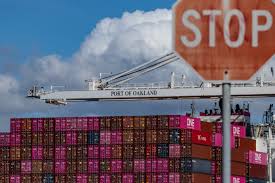
By Dr Mehmood Ul Hassan Khan
The US President Donald Trump series of reciprocal tariffs have shocked allies and adversaries, marginalizing their economies, communities and enterprises alike due to which global governance and trading systems are in immense stress.
Interestingly, Indonesia’s President Prabowo Subianto has described the reciprocal tariff policy as a move that has raised global concerns about the economic landscape.
While delivering his keynote speech at an economic discussion titled “Strengthening Indonesia’s Economic Resilience in the Midst of Trade Tariff Waves” in Jakarta Prabowo rightly expressed concerns over the implications of the U.S. unilateral decision creating pains and panics in the markets. It is a good omen that these concerns, despite the emerging socio-economic and geopolitical trends Prabowo emphasized that his administration will remain calm in responding to U.S. policy shifts through Indonesia’s commitment to economic self-reliance and independent national economy.
On the other hand, even Megawati and Prabowo discussed the US tariff policy during Prabowo’s visit to Megawati’s residence during which both leaders agreed that the US tariff should be used as momentum for the revival of Indonesian products.
It fears that the tariff policy could potentially raise the prices of imported goods, so imports would only be carried out for certain products thus it is high time for Indonesian products to take the lead in the country. 
As visionary leaders President Prabowo and Coordinating Minister for Economic Affairs Airlangga Hartarto have started engaging with ASEAN leaders to develop a coordinated regional response.
The Indonesian government also stated that it would pursue diplomatic channels, including negotiations with the U.S. administration, to address the situation which would be a right policy option in the right direction.
According to the Ministry of Trade, Indonesia recorded a trade surplus of US$14.34 billion with the United States in 2024. Conversely, the U.S. logged a trade deficit of US$17.9 billion in bilateral trade during the same year. Unfortunately, Indonesia has been included in the list of those most affected, with additional tariffs reaching 32 percent.
It is estimated that key Indonesian industries, including textiles, footwear, furniture, rubber, and fisheries, which have relied on the US market as one of their main export destinations, are likely to lose their competitive edge, especially compared to countries with lower tariffs.
Moreover, the US’ reciprocal tariffs could deal a significant blow to the Indonesian footwear industry, which exports 40 percent of its products to the US. Higher import tariffs may increase selling prices, potentially making Indonesian products less competitive than those from countries like Vietnam and Mexico.
It seems that the fisheries sector, particularly shrimp exports, sees a hidden opportunity as Indonesia’s main competitor, Vietnam, faces a 46 percent export tariff. Thus with a holistic and comprehensive strategy, hopefully Indonesian exporters could capture market share from competing countries that are more affected.
It is anticipated that Indonesia’s Composite Stock Price Index (IHSG) may enter a bearish phase following the implementation of import tariffs. However, compared to other major economic shocks, this decline is relatively controlled due to market players’ readiness to anticipate Trump’s several decisions since early 2025.
As a strategy Indonesian investors, businessmen and companies began shifting their portfolios from export-based manufacturing sectors to domestic-focused ones such as infrastructure and consumption even before the presidency of Trump.
Obviously, the Indonesian government has begun taking strategic steps. Coordinating Minister for Economic Affairs Airlangga Hartarto said the government would renegotiate with its US counterpart to find a middle ground regarding this tariff policy.
Many prominent regional economists are of the opinion that Indonesia may face massive layoffs in labor-intensive industries such as electrical and electronics equipment manufacturing, footwear, and garments. Thus a declining trend will happen because Indonesia’s exported goods will no longer be as competitive in terms of pricing.
According to Badan Pusat Statistink 2025, the U.S. has been a major market for Indonesia’s electrical & electronic equipment and footwear exports. In 2024 alone, the U.S. accounted for about 32.08% of Indonesia’s total electrical & electronics equipment export and 37.27% of Indonesia’s total footwear export. Thus a drastic decline is expected in these sectors after the imposition of the US tariffs.
Moreover, weaker global demand will leave Indonesia’s industries even more vulnerable to losing orders and being forced to downsize their workforce.
Additionally, the Indonesian domestic industry would be under pressure from excessive goods redirection in the future. Thus heavy influx of cheap goods redirected from countries like Vietnam, China, and Cambodia would become a bitter reality in Indonesia hurting its own national industries.
It fears that Indonesia may become a spillover market flooded with an oversupply of low-price textiles, garments, footwear, electronics, and other goods.
Local businesses, especially SMEs may face a difficult time to compete against the surge of low-priced imported goods, risking further erosion of market share and employment opportunities. It fears that if not properly managed, this situation could trigger a domino effect i.e. weakening domestic production, hurting business revenues, reducing employment and suppressing economic growth.
Finally, it is projected that Indonesian tax revenues would also be reduced because of the impacts of the 32 percent. According to Badan Pusat Statistik 2025, international trade taxes may contribute only around 2.67% to Indonesia’s domestic revenue in 2024 but their role is still significant. More importantly, the ripple effects could hurt larger segments of its macro-economy, reducing exporters’ profits and corporate incomes, ultimately directly hitting VAT collections as well which contribute 36.30 percent to domestic taxes.
Nevertheless, the ADB latest statement about the US’ 32-percent reciprocal tariff Trump which will not have a significant qualitative impact on Indonesia’s economy is an encouraging sign for its economy and exports.
Indonesia’s total exports to the United States are relatively small. Thus comparatively the impact will not be as severe as the 32-percent tariff suggests.
Exports to the United States account for only around 2 percent of Indonesia’s total GDP. Thus, the economic exposure of both countries, in general, is limited.
Indonesia’s GDP is primarily supported by domestic consumption and investment. Hopefully the US’ reciprocal tariff policy could prompt investors, exporters, and importers to shift their investments and trade away from the United States, thus creating an opportunity for Indonesia.
Thus the repositioning of global trade can be an opportunity for Indonesia to attract investment from abroad, making Indonesia its production base.
Suggestions/Recommendations/Policy Options
It is suggested that besides the government’s negotiations the policy makers of Indonesia should also focus on enhancing the efficiency of its domestic logistics. Comparative studies reveal that currently, logistics costs in Indonesia still account for about 14 percent of the GDP, significantly higher than other countries in the region. Thus reduction of its inefficiency may provide a strategic cushion to Indonesian exports to maintain their competitiveness despite increasing import tariffs in the US.
Amazingly, the ongoing new tariff policy of the USA also presents opportunities in the investment sector. The shift in global supply chains due to the latest US protectionist policies may lead multinational companies that previously operated in Vietnam or China to seek new production destinations that are more stable and not directly affected by Trump’s policies and Indonesia may be an ideal country to make investments and start numerous joint ventures in the days to come. So, policy makers of Indonesia should start a grand economic diplomacy campaign offering an attractive investment ecosystem.
Moreover, the Indonesian government must immediately chalk out supportive policies, mainly structural reforms and meaningful fiscal incentives for investors interested in building production facilities in Indonesia which would be a value addition for its macro-economy during the post US’s tariffs safeguarding its vested economic interests and exports. Additionally, it is suggested that further diversification of the economy, manufacturing capacity, exports, investments for maintaining a stable and sustainable economy successfully navigates global trade dynamics.
The writer submits that the policy makers of Indonesia should initiate coordinated and integrated policies reducing dependence on the US market by strengthening exports to other regions, such as Europe, the Middle East, Asia, Central Asia and Africa. Currently, several countries in the Middle East, Asia specially Pakistan, Uzbekistan and Africa are showing increasing demand for manufactured products and commodities from Indonesia which is a good omen. Thus Indonesian increasing economic ties with these countries would substantially lessen the impact of US tariff policies.
The writer also proposes some strategic steps for the Indonesian government mitigating expected spillover socio-economic, geopolitical and geo-strategic ramifications of the US’ tariffs mainly further fostering sincere efforts to maintain macroeconomic stability and providing support to affected domestic industries, including micro, small, and medium enterprises (MSMEs), which are part of the export industry chain by introducing, initiating and implementing supportive policies, deepening structural reforms and strong but people, investment and business friendly regulatory mechanism improving the ease of doing business. Hopefully these integrated policies would further boost national productivity and export competitiveness of Indonesia. Moreover, multilateral negotiation steps with ASEAN countries would encourage a fairer and more equal international trade order.
As a national policy the Indonesian government should begin finalizing and implementing the expanded bilateral and multilateral trade cooperation agreements and accelerate the completion of ongoing trade negotiations (FTA) with Pakistan, Uzbekistan, Kazakhstan, Ethiopia and other countries of the Middle East and Africa which will eventually broaden Indonesia’s access to new markets.
It is advocated that focusing on improving the efficiency of the manufacturing sector, attracting investments through more proactive policies, and diversifying export markets to reduce dependence on the US would be an effective policy option for the Indonesian administration. On the other hand, the Indonesian regulators must guide investors to the qualitative stocks with strong growth potential to protect their investments and reduce panics in the markets.
The writer endorses that the Indonesian government should not change its domestic component level (TKDN) policy as feared by business players. Thus the TKDN policy must be continued and not be eased for a certain country.
The writer points out that the expansion of trade partner networks, the improvement of local products’ competitiveness, and diversification of the export market should be adopted and implemented as soon as possible which will maintain national economic stability amid the dynamic changes of the global trade. Thus the US must not disrupt the acceleration of down-streaming and industrialization in Indonesia.
Concluding Remarks
Massive deregulation, aiming at reducing economic inefficiencies and improving the global competitiveness of Indonesian products would be a right policy option during this period. Thus the government’s counter-cyclical measures should be prepared to soften the domestic impact of global trade uncertainties.
Additionally the finalization of the Indonesia-European Union Comprehensive Economic Partnership Agreement (IEU-CEPA) would open greater access to European markets.
Thus this policy is also expected to support broader market access for Indonesian products in the US, China, and BRICS countries.
It is recommended that policy makers of Indonesia should immediately send high-level delegation to Washington to negotiate directly with U.S. authorities. It should also work with ASEAN countries for a joint strategy.
Last but not least, the central bank of Indonesia must take all possible measures to stabilize the Rupiah and maintain sufficient foreign currency liquidity for businesses.


